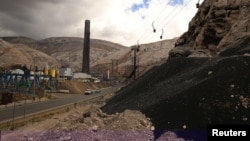Peruvian President Pedro Pablo Kuczynski's efforts to revive a nearly 100-year-old smelting complex could overcome a crucial hurdle at a coming auction where five companies have shown interest in placing bids.
But celebration is far from universal given the sprawling smelter's toxic legacy and Kuczynski's criticism of environmental rules.
Reviving La Oroya, nestled in a destitute region in Peru's central Andes at nearly 3,800 meters (12,500 feet), would mark an early victory in Kuczynski's plan to ramp up the country's smelting capacity to wring more value from mineral shipments that make up at least half of overall export earnings.
Such exalted goals are of little comfort to some La Oroya residents like Sonia Ponce, who worries the government will not do enough to prevent a repeat of the smelter's dirty past. Its smokestacks once spewed so much smoke that midday sometimes appeared to be evening, lacing the soil with heavy metals to a depth of two feet (60 cm) in some parts of town.
Hundreds of children in La Oroya have been found to have dangerous levels of lead in their blood, including Ponce's grandchildren, who once had to spend their days in a different town to reduce their exposure and today cannot keep up with schoolwork.
"They're constantly fatigued," Ponce, 56, said from her home in a hillside slum in La Oroya, blaming the smelter. "It's very sad to see young people grow up sick. No one can give them their health back."
At the same time, scores of La Oroya residents have been agitating for a full revival of the smelter, which ground to a halt in 2009 but has since restarted some zinc production.
Dismissing pollution concerns as exaggerated, they say the town, which has already lost a quarter of its population, will wither away without it.
"It's terrible to live like this," said Marisela Perez as she waited for customers in her grocery shop. "There's no work and businesses are closing."
Finding a new owner for the smelter while ensuring a cleaner operation will be a key test for Kuczynski, 78, who once ran a mine in West Africa for Alcoa Corp, as he seeks to "modernize" the Andean country to cap an illustrious career in finance and public administration.
Obstacle to investments
Five companies, including Chinese-owned steel waste recycler GreenNovo Environmental Technology, have signaled interest in buying the smelter in three days of auctions starting March 10, said Luis Castillo, a workers' representative in the group of creditors overseeing the sale.
Kuczynski said last year the smelter would be able to process copper concentrates from Chinese miner Chinalco's nearby Toromocho mine that contain arsenic levels that surpass Chinese import limits, forcing it to pay special fees.
When the smelter's most recent owner, Doe Run Peru, controlled by New York billionaire Ira Rennert's Renco Group, operated La Oroya, sulfur dioxide emissions sometimes surpassed the daily limit of 365 micrograms by a factor of 10, according to a report by the environment ministry.
"It used to import highly contaminating material to feed the smelter ... that ended up in the city and in residents," said Luis Egocheaga, the former manager of state clean-up agency Activos Mineros that is still working on removing pollution from soil in La Oroya.
Doe Run Peru went bankrupt without finishing mandatory environmental upgrades, saying it had invested heavily to try to transform a creaking unit that had previously been under state control for decades.
A 2015 auction failed to draw any bidders as potential buyers fretted over liability for lingering pollution, labor contracts for some 2,200 workers and an estimated $700 million needed to clean up copper smelting, said Pablo Peschiera, the director of consulting firm Dirige, which is in charge of the bidding.
But Kuczynski, who declined requests to be interviewed, has said it would be cheaper to revive La Oroya if emission limits were looser, calling current standards an obstacle to investment in smelters.
While Peru's national sulfur dioxide limit is far stricter than Canada's, current law allows La Oroya to comply with a looser standard until 2029.
Kuczynski's government has said it is revising environmental rules.
"We want the metallurgical complex to be reactivated, but in an environmentally and socially responsible way," said La Oroya Mayor Carlos Arredondo.







